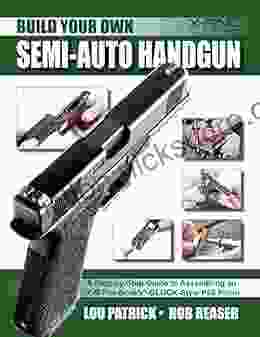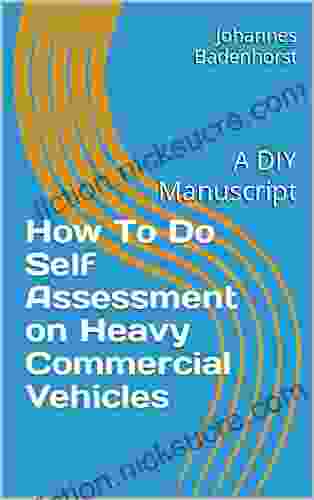Heavy Commercial Vehicle Self-Assessment: A Comprehensive Guide

Ensuring the safety and efficiency of heavy commercial vehicles (HCVs) is crucial for both operators and regulators. Regular self-assessments provide a proactive approach to identifying potential risks, addressing weaknesses, and improving overall performance. This article delves into the essential steps involved in conducting effective self-assessments on HCVs, empowering operators with the knowledge and tools to enhance their safety and compliance.
Step 1: Establish a Framework
The foundation of a successful self-assessment lies in establishing a comprehensive framework that defines the scope, objectives, and methodology of the process. This framework should include:
5 out of 5
| Language | : | English |
| File size | : | 1095 KB |
| Text-to-Speech | : | Enabled |
| Screen Reader | : | Supported |
| Enhanced typesetting | : | Enabled |
| Word Wise | : | Enabled |
| Print length | : | 17 pages |
- Scope: Clearly define the aspects of HCV operations that will be assessed, including maintenance, driver training, safety protocols, and regulatory compliance.
- Objectives: Articulate the specific goals of the self-assessment, such as improving safety outcomes, reducing maintenance costs, or enhancing regulatory compliance.
- Methodology: Outline the techniques and tools that will be employed to gather data, analyze findings, and make recommendations.
Step 2: Gather Data
Accurate and reliable data is essential for identifying areas of strength and weakness. Various sources can be tapped for data collection, including:
- Vehicle maintenance records: Track maintenance activities, including repairs, inspections, and preventive measures.
- Driver training records: Document driver training programs, certifications, and performance evaluations.
- Safety reports: Analyze accident data, near-miss incidents, and corrective actions taken.
- Regulatory compliance records: Maintain a record of inspections, audits, and certifications related to regulatory requirements.
Step 3: Analyze Findings
Once data is gathered, thorough analysis is required to identify trends, patterns, and areas for improvement. This analysis should involve:
- Trend analysis: Examine data over time to identify emerging trends that may indicate potential risks or performance gaps.
- Comparative analysis: Benchmark performance against industry standards or best practices to determine areas where improvements can be made.
- Root cause analysis: Investigate the underlying causes of identified weaknesses to prevent recurrence in the future.
Step 4: Develop Recommendations
Based on the analysis findings, specific recommendations should be formulated to improve performance. These recommendations should be:
- Measurable: Set specific targets or metrics to track progress.
- Achievable: Ensure recommendations are feasible and can be implemented within a reasonable timeframe.
- Relevant: Address the specific areas of weakness identified during the self-assessment.
Step 5: Implement and Monitor
Effective implementation of the recommendations is crucial to achieving the desired improvements. This involves:
- Plan implementation: Develop a clear action plan outlining the steps and responsibilities for implementing the recommendations.
- Training: Provide training to relevant personnel to ensure they understand and are equipped to implement the changes.
- Monitoring: Regularly track progress and make adjustments as needed to ensure recommendations are being effectively implemented.
Benefits of Self-Assessment
Self-assessments offer numerous benefits for HCV operators, including:
- Improved safety: By identifying potential risks and adopting proactive measures, self-assessments contribute to enhancing vehicle safety and reducing accident rates.
- Reduced maintenance costs: Regular maintenance assessments help identify issues early, preventing costly breakdowns and extending vehicle lifespan.
- Enhanced compliance: Self-assessments ensure that HCV operations align with regulatory requirements, minimizing the risk of fines and penalties.
- Improved efficiency: By optimizing maintenance schedules and driver training, self-assessments contribute to increased vehicle availability and reduced operating expenses.
- Informed decision-making: Data-driven insights from self-assessments empower operators with the information needed to make informed decisions about fleet management and safety initiatives.
Regular self-assessments are an essential tool for HCV operators to proactively manage safety, efficiency, and regulatory compliance. By following the steps outlined in this article, operators can establish a comprehensive framework, gather accurate data, analyze findings, develop and implement recommendations, and monitor progress. Embracing self-assessment practices empowers HCV operators to continuously improve performance, enhance safety outcomes, and achieve operational excellence.
5 out of 5
| Language | : | English |
| File size | : | 1095 KB |
| Text-to-Speech | : | Enabled |
| Screen Reader | : | Supported |
| Enhanced typesetting | : | Enabled |
| Word Wise | : | Enabled |
| Print length | : | 17 pages |
Do you want to contribute by writing guest posts on this blog?
Please contact us and send us a resume of previous articles that you have written.
 Fiction
Fiction Non Fiction
Non Fiction Romance
Romance Mystery
Mystery Thriller
Thriller SciFi
SciFi Fantasy
Fantasy Horror
Horror Biography
Biography Selfhelp
Selfhelp Business
Business History
History Classics
Classics Poetry
Poetry Childrens
Childrens Young Adult
Young Adult Educational
Educational Cooking
Cooking Travel
Travel Lifestyle
Lifestyle Spirituality
Spirituality Health
Health Fitness
Fitness Technology
Technology Science
Science Arts
Arts Crafts
Crafts DIY
DIY Gardening
Gardening Petcare
Petcare Richard Louv
Richard Louv Zainab Yate
Zainab Yate Stanislav Grof
Stanislav Grof David E Kaplan
David E Kaplan Patricia A Jennings
Patricia A Jennings Stef Maruch
Stef Maruch Jacob Copeman
Jacob Copeman Richard Barrett
Richard Barrett Janet Sasson Edgette
Janet Sasson Edgette Kathleen Bartholomew
Kathleen Bartholomew Sydney Brake
Sydney Brake Jacqueline Melvin
Jacqueline Melvin Steve Sleight
Steve Sleight Peter Fretwell
Peter Fretwell Mercedes Lackey
Mercedes Lackey Mike Matheny
Mike Matheny Tom Mchale
Tom Mchale Caitlyn Dare
Caitlyn Dare Stephanie Wood
Stephanie Wood David Farrier
David Farrier Drew Smith
Drew Smith Gordon Taylor
Gordon Taylor Gerald Hirigoyen
Gerald Hirigoyen Carolyn Highland
Carolyn Highland Lloyd Freeberg
Lloyd Freeberg Ben Stoeger
Ben Stoeger John Rousmaniere
John Rousmaniere Jane Nelsen
Jane Nelsen Dorothee Haering
Dorothee Haering Eric Butterworth
Eric Butterworth Polo Tate
Polo Tate Anthony J Bennett
Anthony J Bennett John Allyn
John Allyn Jess Mahler
Jess Mahler Robb Manning
Robb Manning Jamie Della
Jamie Della Carolyn P Henly
Carolyn P Henly Julia Albu
Julia Albu Veronica Chambers
Veronica Chambers Nawuth Keat
Nawuth Keat Bob Palmer
Bob Palmer David Kaiser
David Kaiser Julia Scheeres
Julia Scheeres Jon Haws
Jon Haws Carl Zimmer
Carl Zimmer Larry Larsen
Larry Larsen Kathy Malloch
Kathy Malloch Nathan Fox
Nathan Fox Joseph Lumpkin
Joseph Lumpkin John Steinbreder
John Steinbreder Chris Fitch
Chris Fitch Sir Isaac Newton
Sir Isaac Newton Rohan Agarwal
Rohan Agarwal Nadine Hays Pisani
Nadine Hays Pisani Misty Griffin
Misty Griffin Tom Cunliffe
Tom Cunliffe Karl Fulves
Karl Fulves Elizabeth Harmon
Elizabeth Harmon Michael Conway
Michael Conway Melanie Marquis
Melanie Marquis Doug Cook
Doug Cook Ruby Hamad
Ruby Hamad Carlo Zen
Carlo Zen George E Tinker
George E Tinker Starr Casas
Starr Casas Massad Ayoob
Massad Ayoob Susan Campbell Bartoletti
Susan Campbell Bartoletti Lidia Stanton
Lidia Stanton Michael Edelson
Michael Edelson Eileen Edna Power
Eileen Edna Power Vicky Cooper
Vicky Cooper Diane Ackerman
Diane Ackerman P J Hatton
P J Hatton Patrick Sweeney
Patrick Sweeney Randy Vance
Randy Vance Mindy Cockeram
Mindy Cockeram Rob Reaser
Rob Reaser F Brent Neal
F Brent Neal Lauren Drain
Lauren Drain Stephanie Greer
Stephanie Greer Print Replica Kindle Edition
Print Replica Kindle Edition John Balzar
John Balzar Randall Hicks
Randall Hicks Kathryn Allen Rabuzzi
Kathryn Allen Rabuzzi Grant Cunningham
Grant Cunningham James E Wisher
James E Wisher Stephen Harrigan
Stephen Harrigan Yves Pochet
Yves Pochet Rachel Mitchell
Rachel Mitchell Ziya Tong
Ziya Tong Taiwo Oduwoga
Taiwo Oduwoga Kay Burningham
Kay Burningham Martin W Ball
Martin W Ball Jed Jurchenko
Jed Jurchenko Holland C Kirbo
Holland C Kirbo John H Falk
John H Falk Jason Scotts
Jason Scotts Kennedy Achille
Kennedy Achille Eileen Bailey
Eileen Bailey Janet Godwin
Janet Godwin Alfred S Posamentier
Alfred S Posamentier Suellen Ocean
Suellen Ocean Steven Pustay
Steven Pustay Beverly Bell
Beverly Bell Alan Agresti
Alan Agresti Olszewski Marie Erin
Olszewski Marie Erin Teresa Marrone
Teresa Marrone Steve Barrett
Steve Barrett Delaney Ruston
Delaney Ruston Leon Pantenburg
Leon Pantenburg Mark Mazower
Mark Mazower Peter Vermeulen
Peter Vermeulen Mitch Benjamin
Mitch Benjamin John Gray
John Gray Karl Polanyi
Karl Polanyi Richard Carlson
Richard Carlson Nina Manning
Nina Manning Neil Peart
Neil Peart Sean Turriff
Sean Turriff Elizabeth Baquedano
Elizabeth Baquedano Michael Bamberger
Michael Bamberger David Olusoga
David Olusoga Ron Kaplan
Ron Kaplan Petr Beckmann
Petr Beckmann Emma Vanstone
Emma Vanstone Mike Carter
Mike Carter Mark J Hainds
Mark J Hainds Keith H Basso
Keith H Basso Pam Coburn
Pam Coburn Haruki Murakami
Haruki Murakami Greg Vaughn
Greg Vaughn Donald Fenna
Donald Fenna Jack Harris
Jack Harris Christine M Benton
Christine M Benton Paul Barrett
Paul Barrett Pam England
Pam England Michael Deangeli
Michael Deangeli Michael Geers
Michael Geers Russell King
Russell King Michael Martin
Michael Martin Benny Lewis
Benny Lewis Mary Blewitt
Mary Blewitt Jonathan Gelber M D M S
Jonathan Gelber M D M S Louis Berney
Louis Berney Paul Bellow
Paul Bellow Alison Noice
Alison Noice Toyo Kobayashi
Toyo Kobayashi Jane Mersky Leder
Jane Mersky Leder Michelle Maccarthy
Michelle Maccarthy Mike Schultz
Mike Schultz Ross Campbell
Ross Campbell Mike Kephart
Mike Kephart Dk
Dk J T Williams
J T Williams Mike Stallard
Mike Stallard Arin Murphy Hiscock
Arin Murphy Hiscock Christine Lion
Christine Lion John D Kelleher
John D Kelleher Lynn Clark
Lynn Clark Bryan Litz
Bryan Litz Marcia Scheiner
Marcia Scheiner Orly Katz
Orly Katz Grantly Dick Read
Grantly Dick Read Rick Smith
Rick Smith Craig Chappelow
Craig Chappelow United States Air Force
United States Air Force Roald Amundsen
Roald Amundsen Sterling Test Prep
Sterling Test Prep Mark Chang
Mark Chang Glenn Whitman
Glenn Whitman Vincent Chidindu Asogwa
Vincent Chidindu Asogwa Hillary Davis
Hillary Davis Dr Ron M Horner
Dr Ron M Horner Joshua Bloom
Joshua Bloom William Martin
William Martin Barbara Ehrenreich
Barbara Ehrenreich Lilith Starr
Lilith Starr David Levithan
David Levithan Sylvia Hood Washington
Sylvia Hood Washington Randall Bell
Randall Bell Stephen Singular
Stephen Singular Talise Xavier
Talise Xavier Guy Fieri
Guy Fieri John Sabino
John Sabino Dennis L Thombs
Dennis L Thombs Daniel S Milo
Daniel S Milo Kamran Nazeer
Kamran Nazeer Shankar Vedantam
Shankar Vedantam Ivar Dedekam
Ivar Dedekam Britt Hawthorne
Britt Hawthorne Patty Hahne
Patty Hahne N L Mclaughlin
N L Mclaughlin Peterson S
Peterson S Kelley Armstrong
Kelley Armstrong Garth Nix
Garth Nix Kaylene Yoder
Kaylene Yoder Molly Potter
Molly Potter James Felton
James Felton Turk Pipkin
Turk Pipkin Ascencia Pharmacy Technician Exam Prep Team
Ascencia Pharmacy Technician Exam Prep Team Jillian Dodd
Jillian Dodd Julietta Suzuki
Julietta Suzuki The Princeton Review
The Princeton Review Edward Dolnick
Edward Dolnick Jason Padgett
Jason Padgett Tim Macwelch
Tim Macwelch Stan Utley
Stan Utley Ken Johnson
Ken Johnson Linda Lajterman
Linda Lajterman Robert L Park
Robert L Park Anna Rashbrook
Anna Rashbrook Heather Smith Thomas
Heather Smith Thomas Kimberly Nix Berens Phd
Kimberly Nix Berens Phd Monica Gribben
Monica Gribben Dante Fortson
Dante Fortson Gillian Bradshaw
Gillian Bradshaw M J Fievre
M J Fievre Sherry Simpson
Sherry Simpson Pass Your Class
Pass Your Class Sam Fury
Sam Fury Ian Ball
Ian Ball Jack Lagan
Jack Lagan Peter Gandy
Peter Gandy Dave Bergman
Dave Bergman M Helbig
M Helbig Scott Bestul
Scott Bestul Meg Haston
Meg Haston Kate Middleton
Kate Middleton Clive Webb
Clive Webb Jenny Han
Jenny Han J M Hofer
J M Hofer Jane Sanders
Jane Sanders 1st Edition Kindle Edition
1st Edition Kindle Edition Chris Batha
Chris Batha Martise Moore
Martise Moore Malinda Lo
Malinda Lo Angie Green
Angie Green Betsy Childs Howard
Betsy Childs Howard David D Burns
David D Burns Ron Thomson
Ron Thomson Larry Dean Olsen
Larry Dean Olsen Harry K Mcevoy
Harry K Mcevoy Chris Sajnog
Chris Sajnog Veronica Roth
Veronica Roth Mary O Kane
Mary O Kane Isabella Emma
Isabella Emma Lawrence Goldstone
Lawrence Goldstone Catherine Legrand
Catherine Legrand Freddie Fernandez
Freddie Fernandez Charles Rubin
Charles Rubin Ben Greenfield
Ben Greenfield Theodore Brun
Theodore Brun Patti Feuereisen
Patti Feuereisen Og Mandino
Og Mandino Ryan Burden
Ryan Burden Jim Al Khalili
Jim Al Khalili Robert A Sadowski
Robert A Sadowski The Mindset Warrior
The Mindset Warrior Dan Branagan
Dan Branagan Doug Howlett
Doug Howlett Julie Sondra Decker
Julie Sondra Decker David M Killoran
David M Killoran Jan Lantier
Jan Lantier Sarah Krasnostein
Sarah Krasnostein Laura Pavlov
Laura Pavlov Michael Plymel
Michael Plymel Karla Marie Williams
Karla Marie Williams Kindle Edition
Kindle Edition Business Mind
Business Mind Laura Michaud
Laura Michaud Victor J Strecher
Victor J Strecher Izaak Walton
Izaak Walton Michael Pewtherer
Michael Pewtherer Scott Davis Howard
Scott Davis Howard Richard A Mann
Richard A Mann Peter Mcdougall
Peter Mcdougall Malachi Martin
Malachi Martin Gil Reavill
Gil Reavill Jillian M Parsons
Jillian M Parsons Linda Whitenton
Linda Whitenton
Light bulbAdvertise smarter! Our strategic ad space ensures maximum exposure. Reserve your spot today!

 D'Angelo CarterIs For Admission: A Comprehensive Guide to the College Application Process
D'Angelo CarterIs For Admission: A Comprehensive Guide to the College Application Process Robbie CarterFollow ·17k
Robbie CarterFollow ·17k Charles ReedFollow ·16.9k
Charles ReedFollow ·16.9k Harry CookFollow ·11.2k
Harry CookFollow ·11.2k Gavin MitchellFollow ·7.4k
Gavin MitchellFollow ·7.4k Edward BellFollow ·8k
Edward BellFollow ·8k Noah BlairFollow ·3.1k
Noah BlairFollow ·3.1k Jamie BellFollow ·19.3k
Jamie BellFollow ·19.3k Brandon CoxFollow ·7.1k
Brandon CoxFollow ·7.1k

 Charles Bukowski
Charles BukowskiDead Serious: Breaking the Cycle of Teen Suicide
Teen suicide is a...

 Rick Nelson
Rick NelsonSurviving My Years in the Westboro Baptist Church: A...
In the quaint town...

 Edwin Blair
Edwin BlairBuild Your Own Semi Auto Handgun: A Comprehensive Guide...
: Empowering Aspiring...

 Steve Carter
Steve CarterThe Laughing Jesus: Unmasking Religious Lies and...
The Prevailing Paradigm of Christian...

 Brett Simmons
Brett SimmonsComprehensive Fully Illustrated Reference for Modern...
Welcome to the...

 Steven Hayes
Steven HayesFraud, Negligence, and Greed: A Scathing Exposé of the...
**** In the annals of medical malfeasance,...
5 out of 5
| Language | : | English |
| File size | : | 1095 KB |
| Text-to-Speech | : | Enabled |
| Screen Reader | : | Supported |
| Enhanced typesetting | : | Enabled |
| Word Wise | : | Enabled |
| Print length | : | 17 pages |










